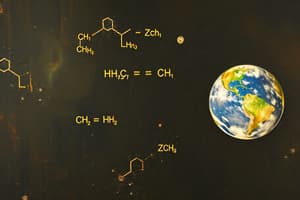Podcast
Questions and Answers
What is the defining characteristic of diatomic molecules?
What is the defining characteristic of diatomic molecules?
- They consist of two identical atoms (correct)
- They are always ionic compounds
- They have a triple bond structure
- They are found exclusively in astrophysics
Which type of bonding can diatomic molecules exhibit?
Which type of bonding can diatomic molecules exhibit?
- Double or triple bonds only
- Ionic, covalent, or polar covalent (correct)
- Hydrogen bonding solely
- Metallic bonding exclusively
Which of the following is an example of a homonuclear diatomic molecule?
Which of the following is an example of a homonuclear diatomic molecule?
- Sodium chloride (NaCl)
- Fluorine (F₂) (correct)
- Carbon monoxide (CO)
- Helium dimers (He₂)
What type of diatomic molecule can form through van der Waals forces?
What type of diatomic molecule can form through van der Waals forces?
In a heteronuclear diatomic molecule, how many different types of atoms are present?
In a heteronuclear diatomic molecule, how many different types of atoms are present?
Which of the following is an example of a heteronuclear diatomic molecule?
Which of the following is an example of a heteronuclear diatomic molecule?
What is the most abundant diatomic molecule in the universe?
What is the most abundant diatomic molecule in the universe?
Why do homonuclear diatomic molecules have molecular orbitals with specific energy levels?
Why do homonuclear diatomic molecules have molecular orbitals with specific energy levels?
What was the significance of diatomic molecules in the development of atomic theory?
What was the significance of diatomic molecules in the development of atomic theory?
How did Avogadro's law contribute to the acceptance of diatomic elemental molecules?
How did Avogadro's law contribute to the acceptance of diatomic elemental molecules?
What type of energy levels can be broken down in diatomic molecules?
What type of energy levels can be broken down in diatomic molecules?
What did Lucy Mensing's work in 1926 focus on?
What did Lucy Mensing's work in 1926 focus on?
Study Notes
Diatomic Molecules
Diatomic molecules are chemical compounds consisting of just two atoms, either two identical atoms (homonuclear) or two different atoms (heteronuclear). They are crucial in various fields, from basic chemistry to astrophysics and cellular biology. This article provides an overview of diatomic molecules, their properties, formation, and significance.
Properties
Diatomic molecules exhibit unique characteristics compared to larger molecules. They are linear in structure, meaning the two atoms are bonded in a straight line. The bonds can be single, double, or triple, depending on the number of electron pairs involved. Additionally, they can be ionic, covalent, or polar covalent, with varying degrees of polarity influenced by the relative electronegativity of the two atoms.
Homonuclear Diatomic Molecules
These are diatomic molecules composed of two identical atoms. Examples include hydrogen (H₂), nitrogen (N₂), fluorine (F₂), chlorine (Cl₂), iodine (I₂), bromine (Br₂), lithium (Li₂), carbon (C₂), and helium (He₂). Helium dimers, specifically, can only form at extremely low temperatures through van der Waals forces.
Heteronuclear Diatomic Molecules
In contrast, heteronuclear diatomic molecules consist of two different types of atoms. Sodium chloride (NaCl), commonly known as table salt, is an example of a heteronuclear diatomic molecule.
Formation and Bonding
Diatomic molecules form through chemical reactions or physical processes under certain conditions. For instance, diatomic nitrogen (N₂) and diatomic oxygen (O₂) make up about 99% of the Earth's atmosphere. Hydrogen (H₂) is the most abundant diatomic molecule in the universe, dominating the interstellar medium.
Bonding within diatomic molecules involves the interaction of atomic orbitals from each atom. In homonuclear diatomic molecules, identical atomic orbitals combine to form molecular orbitals with specific energy levels and properties. For heteronuclear diatomic molecules, the interacting atomic orbitals have different energies due to differences in electronegativity, leading to a skewed molecular orbital energy-level diagram.
Historical Significance and Occurrence
Diatomic molecules played a significant role in the development of atomic theory. John Dalton's early atomic hypothesis assumed all elements were monatomic, but the discovery that some common elements exist as diatomic molecules (such as hydrogen, oxygen, and nitrogen) led to confusion about atomic weights and molecular formulas for half a century. It wasn't until 1860 that Avogadro's law and the concept of diatomic elemental molecules were widely accepted.
Today, hundreds of diatomic molecules are known and studied, both on Earth and in interstellar space. About 99% of Earth's atmosphere consists of two species of diatomic molecules—nitrogen (78%) and oxygen (21%). While many gases exist primarily as polymeric structures, they still form diatomic molecules when evaporated.
Molecular Orbitals and Energy Levels
Studying the molecular orbitals and energy levels of diatomic molecules helps us understand their properties and behavior. These molecules can be described as two-point masses connected by a massless spring, allowing us to break down their energies into translational, rotational, and vibrational categories.
Lucy Mensing's work in 1926 marked one of the earliest quantum mechanical treatments of diatomic molecules. Later, potential functions were developed to give more accurate energy levels, taking multiple vibrational effects into account.
In conclusion, diatomic molecules are fundamental entities in chemistry and physics. Their unique properties and diverse applications continue to fascinate scientists and contribute to our understanding of the universe.
Studying That Suits You
Use AI to generate personalized quizzes and flashcards to suit your learning preferences.
Description
Test your knowledge of diatomic molecules, including their properties, formation, significance, and historical significance. Explore the characteristics of homonuclear and heteronuclear diatomic molecules, their molecular orbitals, and energy levels. Learn about the essential role diatomic molecules play in chemistry, physics, and various scientific disciplines.





